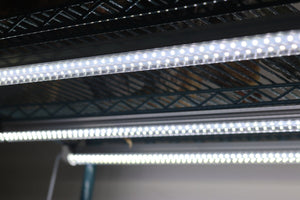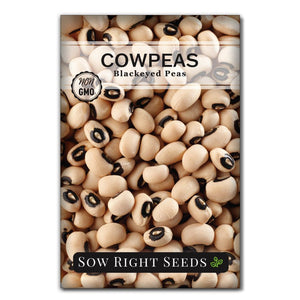How We Start Seeds Indoors: A Behind-the-Scenes Look at Our Grow Station
At Sow Right Seeds, we start hundreds of seedlings every year, and over time, we’ve refined a grow station setup that delivers consistent, vigorous plants. Gardeners ask us about our tools and techniques all the time, so we’re opening up our workspace and sharing the lights, trays, and systems we rely on. Consider this your insider tour of the grow station that helps us achieve reliable germination and sturdy transplants.

When people tell us they can’t get their seeds to germinate indoors or the seedlings die after a week, we always ask, 'What’s your seed starting setup?'
The right setup will save you the frustration of leggy seedlings, damping-off, and other common indoor seed starting issues.

Like many of you, we started growing from seed with cups on the windowsill. But it wasn’t long before we didn’t have room for all the varieties of seeds we wanted to grow.
Over the years, we’ve refined our seed starting setup. Now our indoor grow station is a DIY system that works for us. The principles outlined in our seed starting guide will help you design the right system for your indoor growing space.
You can read all about how to start seeds indoors with our How to Start Seeds Indoors: The Complete Guide. The guide will walk you through the entire process.
Our Seed Starting Grow Station
These are the crucial components that we have in our seed starting grow station:
Seeds
Quality seeds with a high germination rate will make all the difference. Our seeds are sourced from reputable growers and tested to ensure they meet the high germination standard we have at Sow Right Seeds. We guarantee that they will grow. Before we ever set up lights or fill a tray, choosing the right seeds is the first step in setting our grow station up for success.
Containers for Seed Starting
Seeds can be grown in a variety of containers. Because of the number of seeds that we start indoors, my favorite is 1020 trays and inserts. These trays are pretty standard, and you find them almost anywhere that sells gardening supplies. They can be reused each year, saving you money in the long run.
You could start with one tray or buy a bulk batch online. The inserts come in different sizes. You’ll want to consider how long your seeds are going to be in these inserts before potting up or transplanting. I personally would avoid the smallest size of 72 inserts per tray. It’s just too small to keep a seedling in for very long.

Seed Starting Mix
You can buy a ready-made seed-starting mix or make your own. Just remember, it should be light and fluffy to help your seeds germinate. At this stage, you don’t want a heavy soil or potting mix.
Seed-starting mixes are often made from peat moss, perlite, coconut fiber, and vermiculite and have a much finer texture than garden or potting soil. It should hold water without large particles impeding the tender sprouting of seeds.
Here’s our recipe for creating your own seed-starting mix.
Shelving for Seedlings
We use shelves to make the most of the vertical space we have. I suggest you start by looking at what you already have around the house or in the garage, then consider buying used. These shelves will get dirty and wet, so they don't need to be fancy to do the job. My favorite is a 24-inch-wide wire shelf, so the 1020 grow trays fit across it.

Lighting for Seed Starting
Grow lights will ensure your seedlings have enough light to grow. While sometimes a windowsill is good enough, often in the winter months, that won’t be enough sunlight.
We originally used fluorescent lights because that’s what we had available. Full-spectrum LED lights would be the best option, but a bit more expensive.
We upgraded to LED shop lights because they produce more light. We’ve been so happy with the results. You can attach the lights to the shelves with a zip tie to keep them in place.
In our grow station, we use a timer for each set of shelves, and set our lights to 16 hours on and 8 hours off. Having this automated makes a big difference; it’s one less thing to remember each day.
We didn’t do this all at once, but one step at a time, and upgraded a little each year.

Heat Mat
Warm soil will make many seed varieties germinate faster. The heat mat is placed under the seedling trays and keeps the soil warm. Some seeds will germinate in cool soil, but heat makes a big difference in the germination rates of warm-weather plants such as tomatoes, peppers, and some flowers.

Humidity Dome
Keeping the soil moist is essential for ensuring the seeds will sprout. A humidity Dome or plastic wrap is a great way to keep moisture inside the soil until the seedlings germinate. This is helpful for some varieties that are trickier to germinate. I use a dome, plastic wrap, and even shower caps when starting lemongrass, basil, tomatoes, and peppers. This works well in conjunction with a heat mat.
Tomatoes and peppers need warmer soil to germinate, and using a heat mat keeps the soil warm. Both a heat mat and a humidity dome combined will give you the fastest and best germination. Once most of the seeds have sprouted, you should remove the humidity dome or cover.

Spray Bottle
You have to be gentle with these little seedlings. A mister or spray bottle can gently keep the soil moist.
Remember to check on your plants to keep the soil moist. We water from the bottom to keep the soil consistently moist, so we only have to water every couple of days. But I highly recommend checking them daily, because as the seedlings get bigger, you will find they use more water.

Fan
Lastly, while you are taking care of your seedlings, a small fan is a great idea to circulate air, helping your seedlings grow stockier, sturdier stems that are better prepared for outdoor conditions.
As I’m planting seeds, I like to label all my inserts with plant markers so I can keep track of varieties. It’s challenging to remember if you don’t label as you go.

Fertilizing Seedlings
Remember, once those seedlings come up and have their first set of true leaves (which is actually the second set of leaves), they will need nutrition, and you will want to begin applying fertilizer several times a week.
We add a small amount (½ teaspoon) of fertilizer to the watering can every 2-3 days. When we water, the plants receive a microdose of nitrogen and other nutrients.
If you aren’t fertilizing your seedlings yet, I promise it’s a game-changer. Remember, seed-starting mix doesn’t have any nutrients; it’s for germination. So when the seedlings are up, you need to feed them nutrients until they are planted in rich compost and soil outside.

Don’t worry if you can’t set up the ideal grow station all at once. Just do what you can and what makes sense for you. You’ll need trays, inserts, seeds, lights, seed starting mix, and fertilizer to get started for now.
We can help you out when it comes to seeds. We have over 450 varieties of heirloom, non-GMO seeds.
We love our indoor grow station and use it year after year. It makes seed starting a huge success.
Once you set up your indoor grow station, you’ll look forward to starting your seeds every season.
Patty gives a tour of our seed starting station.










Leave a comment